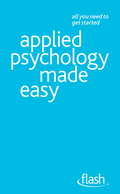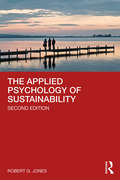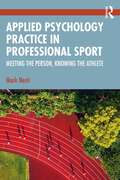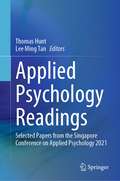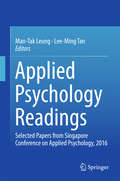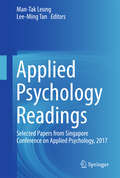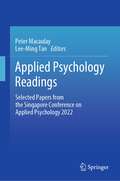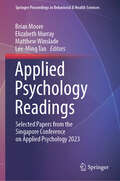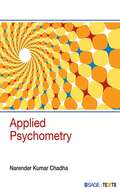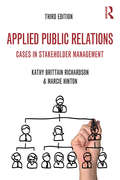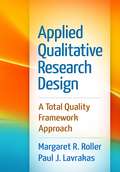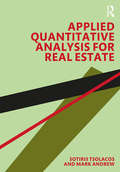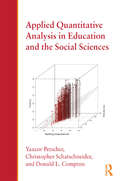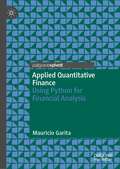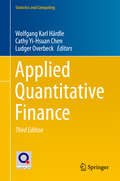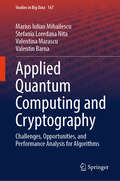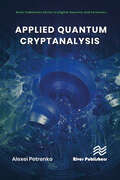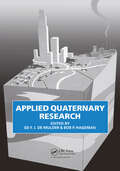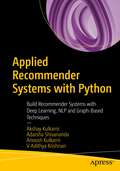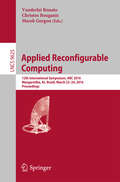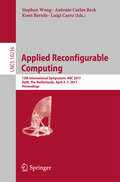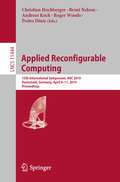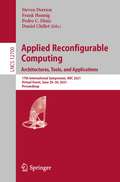- Table View
- List View
Applied Psychology Made Easy: Flash
by Clive ErrickerWant to know about Applied Psychology but short of time and unsure where to begin? Get a kickstart with this little book which will give you just enough to get you going...
Applied Psychology Made Easy: Flash
by Clive ErrickerWant to know about Applied Psychology but short of time and unsure where to begin? Get a kickstart with this little book which will give you just enough to get you going...
The Applied Psychology of Sustainability
by Robert G. JonesWhy doesn’t everyone see sustainability as a huge issue? Why don’t people think more carefully before making choices? What will it take for people to change? Examining the many psychological factors that lead to human behavioral effects on the environment, this book answers these questions definitively and provides practical guidance for approaches that have been used to successfully stimulate change. The Applied Psychology of Sustainability provides an extensive, integrated definition of the processes that lead to climatic, ecological, and socio-economic results: It defines a Psychology of Sustainability. Each chapter applies elements from the core research areas of cognitive, social, and developmental psychology into the context of criteria specific to sustainability. Comprehensively updated to embrace great change in the field, this new edition expands on critical issues yet maintains its strong foundation that the psychology of decisions is the essential precursor to sustainability and that these decisions should be treated as the primary target of change. Throughout the book, readers will find new ways of framing questions related to human adaptability and evolutionary psychology. The Applied Psychology of Sustainability is essential reading for students and professionals in a range of disciplines who wish to contribute to this crucial conversation.
Applied Psychology Practice in Professional Sport: Meeting the Person, Knowing the Athlete
by Mark NestiApplied Psychology Practice in Professional Sport is the first text to draw directly on psychological work delivered over many years to individual players and staff inside English Premier League Football as well as other professional sports, such as cricket, tennis, and golf.A key feature of this new text is the use of examples from the author’s applied practice, to demonstrate that many psychological terms and words used in the “lived world” of high-level professional sport, can be understood with greater depth and meaning where these are informed by more holistic perspectives such as existential, phenomenological, transpersonal and humanistic psychology. Implications for applied sport psychology practice are examined and recommendations offered.Although the book is about professional sport and psychology and is key readings for those associated within this discipline, the ideas and concepts discussed should be familiar to anyone involved in supporting people in challenging performance focused environments such as, business, education, or coaching professions. It is hoped that leaders, managers and other staff from these occupations, and closely related sectors, will find the book interesting and useful.
Applied Psychology Readings: Selected Papers from the Singapore Conference on Applied Psychology 2021
by Thomas Hunt Lee Ming TanThis book is a compilation of the best papers presented at the 2021 edition of the Singapore Conference of Applied Psychology (SCAP) organised and facilitated by East Asia Research in Singapore. The selection of papers addresses the latest innovations, trends, concerns and practical challenges encountered in the field, and poses practical solutions within the field of applied psychology. The theme for 2021 is psychological well-being, and so the collection covers aspects of clinical and non-clinical psychological well-being in different arenas, from education to the workplace. Following a rigorous peer-review process led by the School of Psychology at the University of Derby, this collection is a valuable resource for academics, researchers and practitioners looking to keep themselves up-to-date with recent research in the field. The book is of interest to educators and practitioners in applied psychology focused on well-being.
Applied Psychology Readings: Selected Papers from Singapore Conference on Applied Psychology, 2016
by Man-Tak Leung Lee-Ming TanThis book features the best papers presented at the Singapore Conference on Applied Psychology in 2016. Chapters include research conducted by experts in the field of applied psychology from the Asia-Pacific region, and cover areas such as community and environmental psychology, psychotherapy and counseling, health, child and school psychology, and gender studies. Put together by East Asia Research (Singapore), in collaboration with Hong Kong Shue Yan University, this book serves as a valuable resource for readers wanting to access to the latest research in the field of applied psychology with a focus on Asia-Pacific.
Applied Psychology Readings: Selected Papers From Singapore Conference On Applied Psychology 2016
by Man-Tak Leung Lee-Ming TanThis book is a compilation of the best papers presented at the 2017 edition of the Singapore Conference of Applied Psychology (SCAP), an event held annually in Singapore. Discussing the latest innovations, trends, concerns, practical challenges encountered and the solutions adopted in the field of applied psychology, it is a valuable resource for academics, researchers and practitioners wishing to keep themselves up to date with the state of the art in the field.
Applied Psychology Readings: Selected Papers from the Singapore Conference on Applied Psychology 2022
by Peter Macaulay Lee-Ming TanThis book is a compilation of the best papers presented at the 2022 edition of the Singapore Conference of Applied Psychology (SCAP), led by East Asia Research in Singapore in collaboration with the University of Derby in the UK and the Singapore University of Technology and Design. Chapters include research conducted by experts in the field of applied psychology from the Asia-Pacific region, and cover areas such as community and environmental psychology, psychotherapy and counseling, health, child and school psychology, and gender studies. The volume is of interest to educators, psychology researchers and practicing counselors.
Applied Psychology Readings: Selected Papers from the Singapore Conference on Applied Psychology 2023 (Springer Proceedings in Behavioral & Health Sciences)
by Brian Moore Lee-Ming Tan Elizabeth Murray Matthew WinsladeThis book is a compilation of the best papers presented at the 2023 edition of the Singapore Conference of Applied Psychology (SCAP), led by East Asia Research in Singapore in collaboration with the Singapore University of Technology and Design and Charles Sturt University in Australia. Chapters include research conducted by experts in the field of applied psychology from the Asia-Pacific region, and cover areas such as the latest innovations, trends, concerns, practical challenges encountered and the solutions adopted in the field of applied psychology such as community and environmental psychology, psychotherapy and counseling, health, child and school psychology, and gender studies. The volume will be of interest to educators, psychology researchers and practicing counselors.
Applied Psychometry (SAGE Texts)
by Narender Kumar ChadhaApplied Psychometry is a core textbook on the theory and practice of psychometry for undergraduate, post-graduate, and research students of Behavioural and Social Sciences. It is designed to help students in their study of the following papers: •B.A. Programme Psychology (Core): Psychological Assessment. •B.A. Honours Psychology (Core): Research Method and Psychological Testing. •M.A. Psychology: Research Methodology. •PhD: Quantitative Methods. •B.Ed / M.Ed./ B.P.Ed/ M.P.Ed/ MHROD/MBA(HR). This textbook is also a valuable reference material for practising human resource managers. Applied Psychometry is unique in that it serves a dual purpose. While discussing various aspects of psychometry from an applied perspective, it also takes into account the matching theoretical orientation. The important features of the book include: •Current issues and debates and their implications on the theory and practice of psychometry. •An active teaching–learning interface with many examples and activities. •Chapters on multivariate techniques like factor analysis, its applications and real data treatment. •Construction and standardisation of scales and tests for measurement. •An Instructor′s Manual to facilitate its use and effectiveness in an institutional set-up. This book discusses the application of psychometry in educational, organisational, clinical and developmental settings, among others. It equips its readers with the knowledge of the latest developments in the field and offers guiding solutions to a set of selected research problems.
Applied Public Relations: Cases in Stakeholder Management (Routledge Communication Series)
by Kathy Brittain Richardson Marcie HintonWith its practical orientation and scope, Applied Public Relations is the ideal text for any public relations case studies or public relations management course that places an emphasis on stakeholder groups. Through the presentation of current cases covering a wide variety of industries, locations, and settings, Kathy Richardson and Marcie Hinton examine how real organizations develop and maintain their relationships, offering valuable insights into business and organizational management practices. The book’s organization of case studies allows instructors to use the text in several ways: instructors can focus on specific stakeholders by using the chapters presented; they can focus on particular issues, such as labor relations or crisis management by selecting cases from within several chapters; or they can select cases that contrast campaigns with ongoing programs or managerial behaviors. A focus on ethics and social responsibility underlies the book, and students are challenged to assess the effectiveness of the practices outlined and understand the ethical implications of those choices. This Third Edition features: 25 new and current domestic and international case studies specifically chosen for their relevancy and relatability to students New "Professional Insights" commentaries where practitioners respond to a set of questions relating to their work Increased emphasis on ethics and social responsibility Fully enhanced companion website that is connected with the text, including a test bank and PowerPoint presentations for instructors, and chapter-specific discussion questions and additional readings for students
Applied Qualitative Research Design
by Paul J. Lavrakas Margaret R. RollerThis unique text provides a comprehensive framework for creating, managing, and interpreting qualitative research studies that yield valid and useful information. Examples of studies from a wide range of disciplines illustrate the strengths, limitations, and applications of the primary qualitative methods: in-depth interviews, focus group discussions, ethnography, content analysis, and case study and narrative research. Following a consistent format, chapters show students and researchers how to implement each method within a paradigm-neutral and flexible Total Quality Framework (TQF) comprising four interrelated components: Credibility, Analyzability, Transparency, and Usefulness. Unlike other texts that relegate quality issues to one or two chapters, detailed discussions of such crucial topics as construct validity, interresearcher reliability, researcher bias, and verification strategies are featured throughout. The book also addresses applications of the TQF to the writing, review, and evaluation of qualitative research proposals and manuscripts. Pedagogical Features: *Summary tables that highlight important content, such as the application of a method to vulnerable or hard-to-reach populations. *Case studies that illustrate TQF standards in practice for each method. *Guidelines for effective documentation (via thick descriptions) of each type of study. *End-of-chapter discussion topics, exercises, and suggested further reading and Web resources. *Chapters open with a preview and close with a bulleted summary of key ideas. *Extensive glossary.
Applied Quantitative Analysis for Real Estate
by Sotiris Tsolacos Mark AndrewTo fully function in today’s global real estate industry, students and professionals increasingly need to understand how to implement essential and cutting-edge quantitative techniques. This book presents an easy-to-read guide to applying quantitative analysis in real estate aimed at non-cognate undergraduate and masters students, and meets the requirements of modern professional practice. Through case studies and examples illustrating applications using data sourced from dedicated real estate information providers and major firms in the industry, the book provides an introduction to the foundations underlying statistical data analysis, common data manipulations and understanding descriptive statistics, before gradually building up to more advanced quantitative analysis, modelling and forecasting of real estate markets. Our examples and case studies within the chapters have been specifically compiled for this book and explicitly designed to help the reader acquire a better understanding of the quantitative methods addressed in each chapter. Our objective is to equip readers with the skills needed to confidently carry out their own quantitative analysis and be able to interpret empirical results from academic work and practitioner studies in the field of real estate and in other asset classes. Both undergraduate and masters level students, as well as real estate analysts in the professions, will find this book to be essential reading.
Applied Quantitative Analysis in Education and the Social Sciences
by Yaacov Petscher Christopher Schatschneider Donald L. ComptonTo say that complex data analyses are ubiquitous in the education and social sciences might be an understatement. Funding agencies and peer-review journals alike require that researchers use the most appropriate models and methods for explaining phenomena. Univariate and multivariate data structures often require the application of more rigorous methods than basic correlational or analysis of variance models. Additionally, though a vast set of resources may exist on how to run analysis, difficulties may be encountered when explicit direction is not provided as to how one should run a model and interpret results. The mission of this book is to expose the reader to advanced quantitative methods as it pertains to individual level analysis, multilevel analysis, item-level analysis, and covariance structure analysis. Each chapter is self-contained and follows a common format so that readers can run the analysis and correctly interpret the output for reporting.
Applied Quantitative Finance: Using Python for Financial Analysis
by Mauricio GaritaThis book provides both conceptual knowledge of quantitative finance and a hands-on approach to using Python. It begins with a description of concepts prior to the application of Python with the purpose of understanding how to compute and interpret results. This book offers practical applications in the field of finance concerning Python, a language that is more and more relevant in the financial arena due to big data. This will lead to a better understanding of finance as it gives a descriptive process for students, academics and practitioners.
Applied Quantitative Finance (Statistics and Computing)
by Wolfgang Karl Härdle Cathy Yi-Hsuan Chen Ludger OverbeckThis volume provides practical solutions and introduces recent theoretical developments in risk management, pricing of credit derivatives, quantification of volatility and copula modeling. This third edition is devoted to modern risk analysis based on quantitative methods and textual analytics to meet the current challenges in banking and finance. It includes 14 new contributions and presents a comprehensive, state-of-the-art treatment of cutting-edge methods and topics, such as collateralized debt obligations, the high-frequency analysis of market liquidity, and realized volatility. The book is divided into three parts: Part 1 revisits important market risk issues, while Part 2 introduces novel concepts in credit risk and its management along with updated quantitative methods. The third part discusses the dynamics of risk management and includes risk analysis of energy markets and for cryptocurrencies. Digital assets, such as blockchain-based currencies, have become popular but are theoretically challenging when based on conventional methods. Among others, it introduces a modern text-mining method called dynamic topic modeling in detail and applies it to the message board of Bitcoins. The unique synthesis of theory and practice supported by computational tools is reflected not only in the selection of topics, but also in the fine balance of scientific contributions on practical implementation and theoretical concepts. This link between theory and practice offers theoreticians insights into considerations of applicability and, vice versa, provides practitioners convenient access to new techniques in quantitative finance. Hence the book will appeal both to researchers, including master and PhD students, and practitioners, such as financial engineers. The results presented in the book are fully reproducible and all quantlets needed for calculations are provided on an accompanying website. The Quantlet platform quantlet. de, quantlet. com, quantlet. org is an integrated QuantNet environment consisting of different types of statistics-related documents and program codes. Its goal is to promote reproducibility and offer a platform for sharing validated knowledge native to the social web. QuantNet and the corresponding Data-Driven Documents-based visualization allows readers to reproduce the tables, pictures and calculations inside this Springer book.
Applied Quantum Computing and Cryptography: Challenges, Opportunities, and Performance Analysis for Algorithms (Studies in Big Data #167)
by Marius Iulian Mihailescu Stefania Loredana Nita Valentina Marascu Valentin BarnaThis book explores the dynamically developing areas of quantum computing and quantum cryptography. The book offers an in-depth examination of the possibilities and difficulties presented by these revolutionary technologies, with the goal of connecting abstract ideas with real-world applications. The book is an extremely helpful resource in the context of the upcoming quantum age. This highlights the importance of creating cryptographic techniques that can withstand the power of quantum computers to protect digital communications and vital infrastructures. This work makes a substantial contribution to the topic of cybersecurity by doing a comprehensive analysis of classical and quantum cryptography approaches, as well as actual implementations and performance evaluations. The book plays a vital role in providing valuable guidance to researchers, practitioners, and policymakers. It offers valuable insights that are necessary for effectively managing the shift towards quantum-secure technology and safeguarding the future security of digital information.
Applied Quantum Cryptanalysis
by Alexei PetrenkoToday we witness an explosive growth in attention to Q-computing. Q-computing technologies, along with artificial intelligence (AI) and machine learning (ML) technologies, cloud and foggy computing, as well as technologies for collecting and streaming processing of Big Data and ETL, are constantly leading the lists of ""end-to-end"" information technologies for the digital economy of technologically developed countries of the world. One of the main reasons for this is the potential ability of quantum computers to solve some computational problems more efficiently than any of the most modern classical computers of the von Neumann architecture (supercomputers). The most expressive and interesting, from an applied point of view, examples of such problems are integer factorization, effectively performed by Shor's quantum algorithm, as well as record search in an unordered database, effectively solved by Grover's algorithm. This monograph contains the best practice for solving problems of quantum cryptanalysis to improve cyber security and resilience of the digital economy. The book discusses well-known and author's software implementations of promising quantum Shor algorithms, Grover, Simon et al. Shor's algorithm provides exponential acceleration of solving factorization problems, discrete logarithm problems (DLPs) and elliptic curve discrete logarithm problems (ECDLPs). The mentioned tasks are widely used in TLS, SSH or IPsec cryptographic applications of Internet/Intranet and IIoT/IoT networks, communication protocols based on Diffie–Hellman key agreements (dependent on the strength of the DLP or ECDLP), digital signature algorithms (DSA, ECDSA, RSA-PSS), public key encryption algorithms (El Gamal, RSA-OAEP), etc. In other words, Shor's quantum algorithm is potentially capable of violating these algorithms, and with them all the mechanisms of public-key cryptography deployed in cyberspace.
Applied Quaternary Research
by ED F.J.DE MULDER Bob P. HagemanProceedings of a symposium at the 1987 INQUA Congress, Ottawa, Aug. 1987. Contributions present the application of quaternary studies to land use planning and development. No index. Annotation copyright Book News, Inc. Portland, Or.
Applied Radiological Anatomy
by Jeremiah C. Healy Paul Butler Adam W. M. MitchellThis expanded new, full colour edition of the classic Applied Radiological Anatomy is an exhaustive yet practical imaging resource of every organ system using all diagnostic modalities. Every illustration has been replaced, providing the most accurate and up-to-date radiographic scans available. Features of the second edition: * Completely new radiographic images throughout, giving the best possible anatomic examples currently available * Both normal anatomy and normal variants shown * Numerous colour line illustrations of key anatomy to aid interpretation of scans * Concise text and numerous bullet-lists enhance the images and enable quick assimilation of key anatomic features * Every imaging modality included Edited and written by a team of radiologists with a wealth of diagnostic experience and teaching expertise, and lavishly illustrated with over 1,000 completely new, state-of-the-art images, Applied Radiological Anatomy, second edition, is an essential purchase for radiologists at any stage of their career.
Applied Recommender Systems with Python: Build Recommender Systems with Deep Learning, NLP and Graph-Based Techniques
by Akshay Kulkarni Adarsha Shivananda Anoosh Kulkarni V Adithya KrishnanThis book will teach you how to build recommender systems with machine learning algorithms using Python. Recommender systems have become an essential part of every internet-based business today. You'll start by learning basic concepts of recommender systems, with an overview of different types of recommender engines and how they function. Next, you will see how to build recommender systems with traditional algorithms such as market basket analysis and content- and knowledge-based recommender systems with NLP. The authors then demonstrate techniques such as collaborative filtering using matrix factorization and hybrid recommender systems that incorporate both content-based and collaborative filtering techniques. This is followed by a tutorial on building machine learning-based recommender systems using clustering and classification algorithms like K-means and random forest. The last chapters cover NLP, deep learning, and graph-based techniques to build a recommender engine. Each chapter includes data preparation, multiple ways to evaluate and optimize the recommender systems, supporting examples, and illustrations. By the end of this book, you will understand and be able to build recommender systems with various tools and techniques with machine learning, deep learning, and graph-based algorithms.What You Will LearnUnderstand and implement different recommender systems techniques with PythonEmploy popular methods like content- and knowledge-based, collaborative filtering, market basket analysis, and matrix factorization Build hybrid recommender systems that incorporate both content-based and collaborative filteringLeverage machine learning, NLP, and deep learning for building recommender systems Who This Book Is ForData scientists, machine learning engineers, and Python programmers interested in building and implementing recommender systems to solve problems.
Applied Reconfigurable Computing: 12th International Symposium, ARC 2016 Mangaratiba, RJ, Brazil, March 22–24, 2016 Proceedings (Lecture Notes in Computer Science #9625)
by Vanderlei Bonato Christos Bouganis Marek GorgonThis book constitutesthe refereed proceedings of the 12th International Symposium on AppliedReconfigurable Computing, ARC 2016, held in Rio de Janeiro, Brazil, in March2016. The 20 full papers presentedin this volume were carefully reviewed and selected from 47 submissions. Theyare organized in topical headings named: video and image processing; fault-tolerantsystems; tools and architectures; signal processing; and multicore systems. In addition, the bookcontains 3 invited papers and 8 poster papers on funded RD running and completed projects.
Applied Reconfigurable Computing: 13th International Symposium, ARC 2017, Delft, The Netherlands, April 3-7, 2017, Proceedings (Lecture Notes in Computer Science #10216)
by Luigi Carro Antonio Carlos Beck Koen Bertels Stephan WongThis book constitutes the refereed proceedings of the 13th International Symposium on Applied Reconfigurable Computing, ARC 2017, held in Delft, The Netherlands, in April 2017. The 17 full papers and 11 short papers presented in this volume were carefully reviewed and selected from 49 submissions. They are organized in topical sections on adaptive architectures, embedded computing and security, simulation and synthesis, design space exploration, fault tolerance, FGPA-based designs, neural neworks, and languages and estimation techniques.
Applied Reconfigurable Computing: 15th International Symposium, ARC 2019, Darmstadt, Germany, April 9–11, 2019, Proceedings (Lecture Notes in Computer Science #11444)
by Roger Woods Christian Hochberger Brent Nelson Andreas Koch Pedro DinizThis book constitutes the proceedings of the 15th International Symposium on Applied Reconfigurable Computing, ARC 2019, held in Darmstadt, Germany, in April 2019. The 20 full papers and 7 short papers presented in this volume were carefully reviewed and selected from 52 submissions. In addition, the volume contains 1 invited paper. The papers were organized in topical sections named: Applications; partial reconfiguration and security; image/video processing; high-level synthesis; CGRAs and vector processing; architectures; design frameworks and methodology; convolutional neural networks.
Applied Reconfigurable Computing. Architectures, Tools, and Applications: 17th International Symposium, ARC 2021, Virtual Event, June 29–30, 2021, Proceedings (Lecture Notes in Computer Science #12700)
by Steven Derrien Frank Hannig Pedro C. Diniz Daniel ChilletThis book constitutes the proceedings of the 17th International Symposium on Applied Reconfigurable Computing, ARC 2021, held as a virtual event, in June 2021. The 14 full papers and 11 short presentations presented in this volume were carefully reviewed and selected from 40 submissions. The papers cover a broad spectrum of applications of reconfigurable computing, from driving assistance, data and graph processing acceleration, computer security to the societal relevant topic of supporting early diagnosis of Covid infectious conditions.
